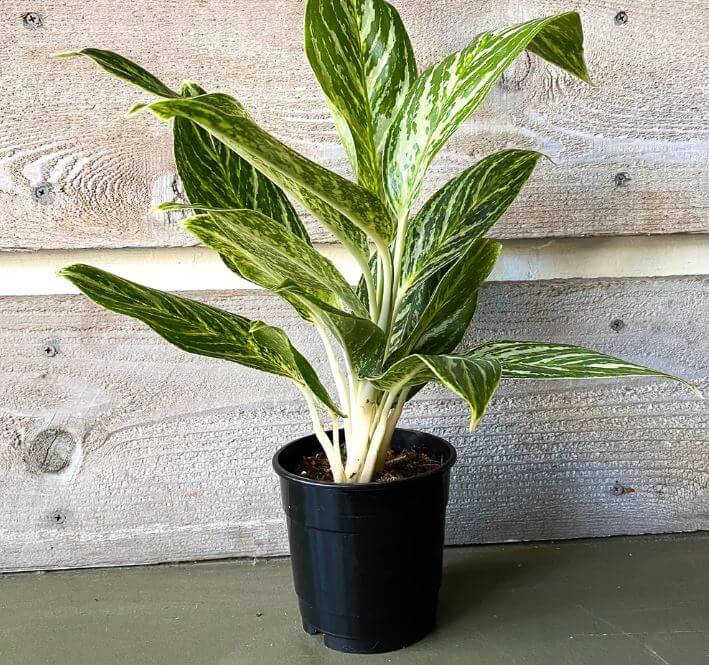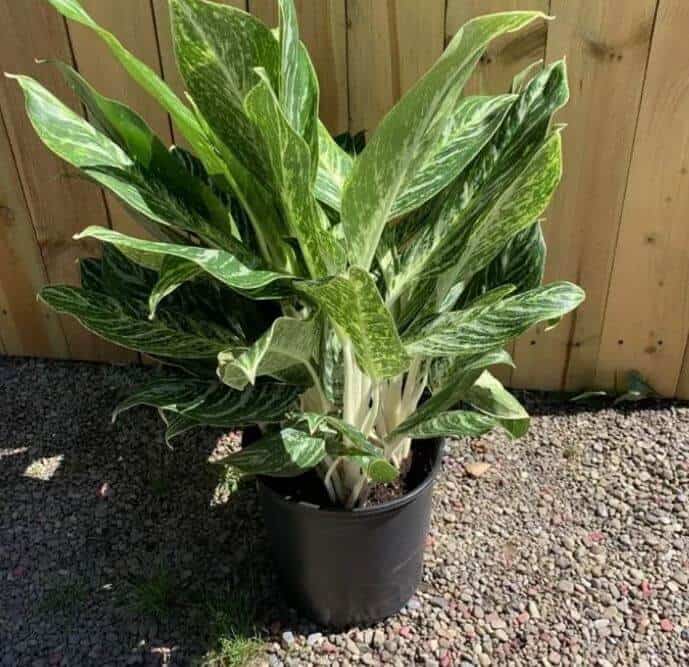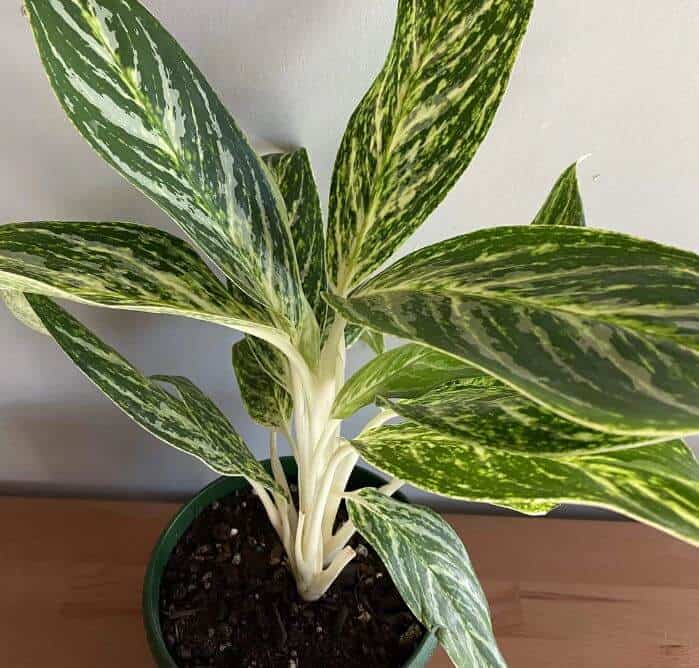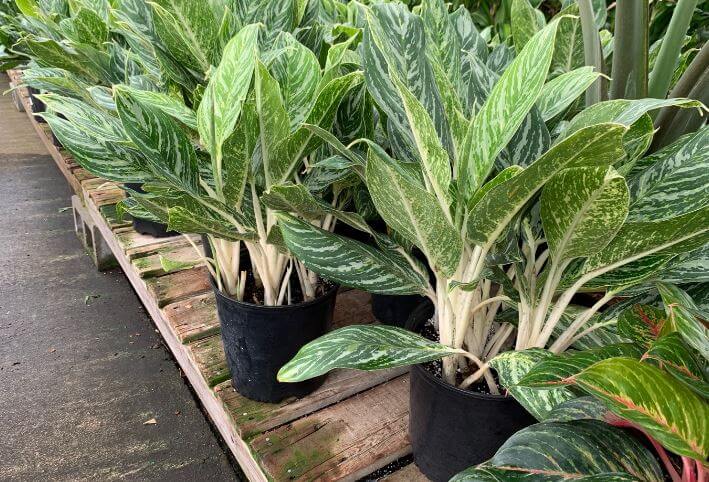Last Updated on January 6, 2023 by a Friendly Gardener
With a centuries-old reputation as a luck bringer, the beautiful Golden Madonna is an excellent starter plant that can instantly spruce up any space with its gorgeous foliage.
Also known as the Aglaonema Madonna, the Aglaonema Golden Madonna, or simply the Chinese Evergreen, the Golden Madonna plant is native to the tropics and subtropics of New Guinea and Asia and was first introduced to western shores in the late 1800s.
Since then, the flowering plant has been bred, cultivated, and hybridized into an extensive range of cultivars.
If you’re adding a Golden Madonna to your plant family, here’s everything you need to know about growing and caring for the plant.
The Golden Madonna: An Introduction

The Golden Madonna earned its name for its lovely golden-yellow-gray, bright, and variegated leaves.
As indicated above, the plant has been cultivated for centuries now and is a genus of flowering plants belonging to the Araceae arum family.
Though we know that it is native to regions of Asia and New Guinea, tracing the Golden Madonna’s exact origins has been a challenge, given how old it is. Regardless, the plant enjoys a prime position in indoor decor and plantscaping.
Description
The Golden Madonna is a perennial, evergreen plant with variegated leaves that curve upwards from the plant’s mid vein. The leaves, 9-10 centimeters (3.5-3.9 inches) in width and 28-30 centimeters (11-11.8 inches) in length, feature a beautiful mix of yellow and white/silver in swirling patterns, set against a light or dark green base leaf color.
At its tallest, which it reaches within 7 months or so, the plant can extend up to 46 centimeters (18 inches) in height. The plant is a flowering plant that blooms in the warmth of summer, with a fleshy, red, berry-like fruit.
Golden Madonna Plant Care

Golden Madonna plant care is actually quite simple since this is a plant that doesn’t require much to thrive. If you want the Golden Madonna to thrive in your garden or on your desk, emulating its native conditions as much as possible will help your plant live a full, happy life.
Luckily, with just a few, simple steps, this is easily achievable!
Temperature Requirements
As we know, the Golden Madonna is native to tropical and subtropical regions, which enjoy warmth and sunshine throughout the year, and requires the same conditions to grow elsewhere.
This means that these plants require constant ambient temperatures between 65℉ and 75℉.
Since most houses have natural internal temperatures sitting in this range, Golden Madonnas can thrive indoors.
Golden Madonna plants detest the cold, a condition they’re not exposed to in their native environments.
Cold environments (temperatures drop below 60℉) and temperature fluctuations can significantly harm these plants, so keep your Golden Madonna away from cold drafts, cold spots, air conditioners, and any devices whose temperatures fluctuate, such as radiators, stoves, heaters, and fireplaces.
In case you live in a region that gets quite cold quite often, make sure that you keep the plant indoors when the temperature starts dropping; your Madonna won’t make it through a cold winter.
If you do want to grow your Golden Madonna outdoors, USDA Hardiness Zones 10 to 12 offer the best growing conditions for the plant, as they’re closest to the plant’s native environments.
Light Requirements

Golden Madonnas do well in indirect light that ranges in intensity from medium to high.
The light requirements of this particular variety are higher due to its variegated coloring; this means there’s less surface area to synthesize sunlight into chlorophyll, compared to Chinese Evergreens with solidly colored leaves. Therefore, these plants make up for their insufficient chlorophyll with extra light.
A good way to judge whether your Golden Madonna is getting sufficient light is to check its leaves. In insufficient light, the variegations will slowly start fading.
Similarly, you don’t want to expose your plant to extremely intense, direct light, as this could cause yellowing and dulling in the leaves, and even scorching, burns, marks, and patches, eventually.
If your Madonna enjoys a spot on your windowsill, it’s a good idea to filter the light with thin drapes or curtains. East-facing windows are ideal since the light is gentler here.
If your plant is outdoors, make sure that it’s in a shaded spot.
Humidity Requirements
The humidity should ideally be 50% and above for Golden Madonnas, but the plant can do just fine in low humidity, too. Humidity will help your plant grow better and faster, with more leaves and better colors, but low humidity will not harm your plant.
A hygrometer will help you measure the humidity if you’re aiming for 50% or higher.
However, it’s highly essential that your Madonna doesn’t sit in a dry-air environment, as dry air can cause the tips of the leaves to turn irreversibly brown; your only option, in this case, will be to trim the leaves. Not trimming in time will lead to the browning spreading and affecting more leaves.
If you live in a dry region, a humidifier will help you maintain the required levels of humidity.
Water Requirements
Golden Madonnas require moist soil—not soggy or wet, but moist!
Finding this balance can be tricky, especially in the beginning, but you’ll soon get the hang of it. A good trick to prevent overwatering or underwatering is to ensure that the top couple of inches of the potting soil are dry to the touch before you water the plant again.
Underwatering and overwatering can both damage your Madonna’s roots; the former can lead to breakage and wilting while the latter can lead to the more harmful root rot, a condition that can potentially kill your plant.
Soil and Fertilizer Requirements

Golden Madonnas need light, organically rich, and well-draining soil that isn’t too sandy or heavy. This will help the plant retain moisture while also preventing the dangers of waterlogging and overwatering.
Mixing equal parts of perlite, peat, and potting mix will help you arrive at the ideal soil mix for your Golden Madonna, and repotting once every two or three years, during spring, will keep the soil sufficiently fresh and nutritious for your plant.
Fertilizing the plant is recommended once a month during the winter and spring months with diluted, water-soluble fertilizer. You could alternatively use slow-release pellets or organic options like fish fertilizer or emulsion.
Golden Madonna Risks
Golden Madonnas are susceptible to pests and diseases such as scale, mealybugs, spider mites, root rot, and fungal and bacterial infections. Insecticides such as neem oil can help keep pests and infections at bay, whereas preventing overwatering will keep root rot at bay.
Wrapping Up

If you have pets and small children around, though, be careful, as the plant’s stems and leaves can be toxic when ingested.
If you want to propagate your plant, you can do so with stem cuttings and divisions.
The Golden Madonna is an easy-to-care-for plan that’s a great addition to any space, so if you’re considering bringing home this plant, go right ahead!

